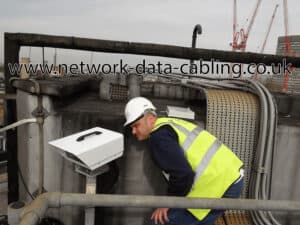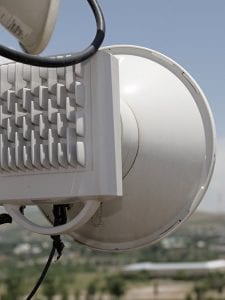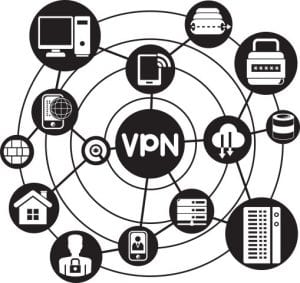
Some businesses do it by necessity. Others, for the opportunities it brings, especially in customer-driven fields like retail. In 2017, more than 60,000 businesses operated in more than one unit. More than 25% percent of the local sites in the UK belong to companies that operate in more than one site.
Interconnecting multiple sites in a single, private network is one of the most significant technical challenges that a business can face. There are multiple solutions – all of them offering a different mixture of distance, bandwidth, cost and security – and choosing the right one is one of the most critical decisions that business owners and IT managers face.
Let’s explore these options together.

Like all networks, a network that spans multiple sites – or at least the section that interconnects the sites – can be wired or wireless. There is no magic there, but the technology isn’t the same one that you know from short-distance, office networks.
Over reasonably short distances – ranging from “across the street” to “a few hundreds of meters or a few kilometers”, it is usually possible to run your own data infrastructure, whether wired or wireless. The most important challenges are strictly technical in nature – running cables outdoors and/or over distances higher than 100 meters, or operating wireless equipment.
Over medium and long distances – several streets apart, or across the city – the waters are considerably murkier.
Fully private cables are prohibitively expensive to run over very long distances, or outright impossible to do if you are not a telecom operator. VPN over regular data connections are the most cost-sensible choice.
But companies with strenuous bandwidth and latency requirements will usually need to run a VPN connection over a dedicated line. Wireless options are also available, and they are very flexible and efficient to deploy, but they shift the maintenance burden to the user.

Speaking strictly in technical terms, the easiest scenario is when the offices that you want to connect are close to each other. This can mean as close as across the street from each other, or as far apart as a few hundreds of meters or even a few kilometers away, but within the limits of the same property.
The most straightforward option is to connect all sites to the Internet using regular broadband line, and run a virtual private network (VPN) over the Internet. A VPN is much like a wired link established between two endpoints (i.e. between the LAN networks in each building), where the data isn’t transmitted over a single, wired link, but routed over the Internet. The data is encrypted, since it needs to pass through equipment not owned by the VPN’s operator.
A VPN over such an infrastructure is the most cost-effective solution, but it suffers from high and variable latency. The latency is inherently high because traffic needs to pass through the Internet provider’s infrastructure – and it can vary significantly, because there is no guarantee that it will take the same path all the time, and whatever path it takes can be too busy to accommodate all the traffic you need.
These factors can be mitigated to some degree by using a dedicated or leased line. A dedicated line is a direct link to the Internet provider’s core network, which is not shared with any other users – unlike typical broadband links, which are used by several users in the same building (or sometimes by several buildings at once).
This means that the entire capacity of the line is available for your network, and that the data path will usually be the same at all times. However, leased lines can be expensive; depending on region, a 1 Gb/s dedicated line can cost up to 500-800 GPB/month. They also leave you dependent on your ISP’s infrastructure – from cabling to switching equipment.

Copper cabling is the most straightforward choice, and – if correctly installed – it can be sufficient. Cat-6a cable – the highest-rated type of Cat6 Ethernet cable – is guaranteed to work over distances as high as 100 meters, at speeds up to 10 Gb/s. This is enough for many short-distance links. Higher speeds and distances can only be serviced through installing fibre optic cables.
Multi-mode fibre optic cables can carry data at 10 Gb/s over distances as high as 300 meters (for OM3 cables) or 400 meters (for OM4) cables, but higher speeds are achievable as well (albeit over shorter distances: OM4 cable can carry 40 Gbit/s data over no more than 150 meters). Single-mode fibre optic cables can carry 10 Gbit/s signals over distances up to 10 km.
Regardless of cable choice, the biggest challenge is having to run cable outdoors. This can involve both technical and legal issues.
When deployed outdoors, cable is subjected to environmental factors such as temperature, humidity or lightning strikes, and to higher levels of EM interference. Coping with this problems involves:
Depending on location and property status, deploying cables may also require special approvals from local or government authorities. Applications involve a great deal of documentation, and the review process can take up to 12 months. This sort of timeframe is not always available when you need to quickly seize development opportunities.

Besides bandwidth, latency and convenience, the most compelling advantage of a direct wired connection is security. Network cables can be tapped, but if they are installed on secure premises, they are as secure as anything else on that property.
Dedicated, on-premise copper or fibre cables are not shared with other users, so there is no way that a malicious user can exhaust the network’s capacity. And they do not depend on any ISP’s infrastructure, so if an attacker (even one not directly interested in your business) brings your ISP offline, your organization’s internal traffic is not affected.
Finally, your company’s internal traffic never has to flow through infrastructure not owned by your company and not under your control, which makes it much harder to compromise data at the network’s physical layer.
Over distances up to about 100 meters, even regular, off-the-shelf WiFi equipment can be an option. Installing Wi-Fi repeaters allows you to extend this range. This option is cheap, but it is highly sensitive to environmental condition, and usually results in high latency. Over these distances, copper or fibre optic cabling will invariably offer better performance.
When higher bandwidth, lower latency, or longer distances – up to a few kilometers – are required, free to air solutions are a class of useful alternatives. The “free” in “free-to-air” refers to the fact that you are free to broadcast the signal without requiring special approvals or licenses, as long as the equipment operates within certain frequency bands and below a specific power threshold (e.g. below 1W in the 5.470 – 5.725 GHz band).
There are two primary options for free-to-air links over short distances: Free Space Optics (FSO) laser , and short-range microwave links. Both offer competitive speeds, but are more complex than copper or fibre cabling.

FSO laser links are point-to-point links which use highly-focused laser beams to transfer data – a method that enables data transmission at rates of up to 10 Gb/s, with very low latency levels. FSO laser links don’t require a license to operate (or approvals to bury cables) and are immune to RF interference. However, they cannot penetrate walls and are susceptible to environment conditions such as rain and fog.
Both FSO and microwave links are point-to-point technologies, so they need to have antennas and associated radio equipment installed on both sites. They also require a clear, unobstructed line of sight between its two endpoints.
Maintenance and operating costs do tend to be lower than those of a leased line. But the radio equipment involved is nonetheless more complex than your typical Ethernet switch, so there are other associated costs in terms of engineering talent and logistics.

Depending on each building’s height, on its neighbouring buildings’ heights, and on the environmental conditions in your area, the longest distance that line of sight equipment can theoretically cover is in the region of 10-20 kilometers. Fibre links can cover this sort of distance as well, but it is unlikely for a company that is not a telecom operator to be able to run 10 kilometers of fibre through a city.
What are your options for such distances?
VPN links over existing infrastructure are, once again, the most straightforward choice. There is no inherent limit to the distance that a VPN link allows – indeed, VPN links with endpoints as far apart as Toronto and Sydney are perfectly usable for applications that are not too latency-sensitive.
This alternative is particularly compelling for long-distance links, where other wired options are simply not available, and radio links require more complicated equipment. A leased line enables latency levels that are well within the limits that most companies can work with, and requires no maintenance and no complex radio equipment.
Long-range microwave links are the only mainstream wireless alternative for long-distance data links. Like line-of-sight microwave links, they use radio waves in the microwave spectrum to connect two sites – but they also use additional equipment between them to relay the signals, thus covering longer distances
Such systems can reach speeds of up to 1.25 Gbps, and cover distances of up to 60 kilometers. They offer excellent latency and speed, a great deal of flexibility and a high level of security – but they are significantly more expensive than a VPN link over a dedicated line.

The rule of thumb is that if you can run your own copper or fibre cables, and you have the means to maintain a networking infrastructure that’s partially outdoors, you should. The most straightforward way to interconnect two networks is to run a cable between them; if you can, you should.
For most small and medium businesses, VPN links are a perfectly appropriate and secure option, at any distance. For small distances within the confines of the same property, you should think of other options first – but if running your own cables is difficult, a VPN is the first thing you should consider.
In terms of cable choice, your first option should be shielded, twisted-pair copper cables. They are cheaper and easier to install. If bandwidth or distance requirements exceed their capabilities, fibre optic is the next best alternative.
Over short distances, free-to-air data links offer excellent latency levels, which is particularly important for applications such as high-frequency trading and other financial operations. Free-to-air data links can also be cheaper than a leased line, especially in crowded urban areas. However, they do require the installation and maintenance of dedicated laser or RF equipment. Extreme weather conditions can also affect their operation, to a much higher degree than that of leased lines.
For long distances, VPN connections are a far more compelling alternative, especially for typical office use scenarios, where a leased line can more than match the bandwidth requirements of a busy office day, and the latency requirements are relaxed. However, wherever latency and security concerns can justify the installation and maintenance costs, long-range microwave links can support even the most demanding applications.

There are many methods, both wired and wireless, which can be employed to provide a reliable connection between a business’ offices. Each of these options lands in a different spot within a perimeter defined by distance, latency, bandwidth, security and cost.
Wired infrastructure, using copper or fibre optic cabling, is the most accessible choice. Where they cannot be deployed, for example due to distance and legal constraints, point-to-point line of sight technologies can be a viable option.
Especially when long distances and high-level security concerns are involved, these infrastructure-related decisions are long-term commitments; they can be expensive, and difficult to roll back once they have been deployed.
So you need to make sure that your investment is future-proof. We can help with that! Our FREE, no-obligations survey is designed to help you find the best solution in terms of costs, reliability and performance for inter-building communications.
Services mentioned in this blog post: Free to air, Free Space Optics, Microwave Bridges, Radio installations
Related topics: How to set up WiFi in Office